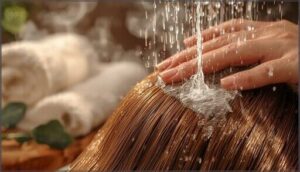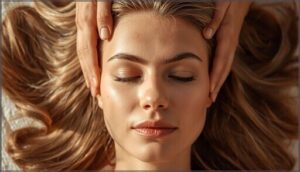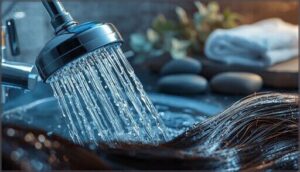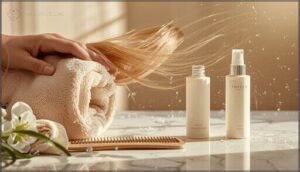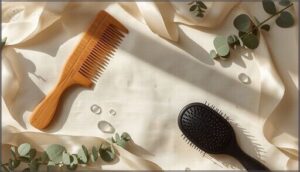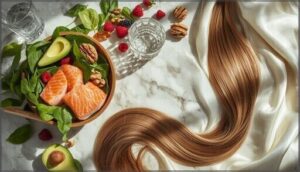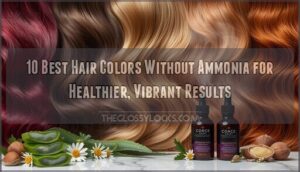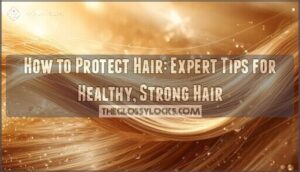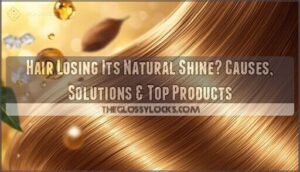This site is supported by our readers. We may earn a commission, at no cost to you, if you purchase through links.
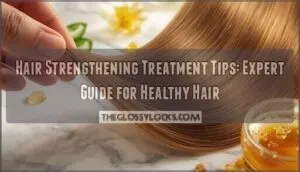
The good news: transforming weak, damaged hair into resilient, healthy locks doesn’t require expensive salon appointments or mystery potions. Strategic hair strengthening treatment tips target the root causes of breakage—from cuticle damage to moisture loss—using science-backed methods you can master at home.
Whether you’re recovering from heat damage, chemical processing, or years of rough treatment, these proven techniques rebuild your hair’s internal structure and fortify its defenses against future damage.
Table Of Contents
Key Takeaways
- Your hair’s strength depends equally on what you put inside your body and what you do to it daily—protein intake, hydration, stress management, and sleep directly impact follicle function and strand resilience, while proper washing frequency, gentle handling, and heat protection prevent external damage from undoing internal gains.
- Molecular repair treatments like K18 and Olaplex don’t just coat your hair—they rebuild broken keratin chains and disulfide bonds at the cortex level, delivering measurable improvements (up to 68% less breakage) that address chemical and heat damage most surface treatments can’t touch.
- The difference between surface fixes and real repair comes down to targeting structural damage versus cosmetic symptoms—weekly deep conditioning masks with amino acids and protective oils restore moisture balance and cuticle integrity, while recognizing whether you’re dealing with protein loss or cuticle erosion determines which treatment actually works.
- Consistency beats intensity when strengthening hair—daily habits like scalp massage, cool water rinsing, and gentle detangling compound over time to prevent breakage, while strategic weekly treatments repair existing damage without the need for constant salon visits or expensive interventions.
Essential Daily Habits for Stronger Hair
Your hair’s strength isn’t about pricey treatments—it’s built through daily habits. How you wash, touch, and handle your strands determines whether they break or stay resilient.
Here are five practices that’ll shift your hair from fragile to fortified.
Proper Washing Frequency and Technique
Most people wash their hair too often—and when they do, they’re probably doing it wrong. Here’s what actually works for hair strengthening and scalp health:
- Wash 2-3 times weekly to preserve natural oils that protect your hair
- Use a quarter-sized amount of shampoo, focusing on your scalp rather than lengths
- Apply lukewarm water for washing—hot water strips moisture and weakens strands
- Rinse with cool water to seal cuticles and boost shine
It’s not about scrubbing harder—gentle washing keeps your hair strong and moisturized over time.
Scalp Massage Benefits and Methods
Your scalp holds the secret to stronger hair, and it only takes four minutes a day to reveal it. Daily scalp massage boosts blood circulation to hair follicles, increasing thickness and strength, while doubling as relaxation therapy. Use firm, circular motions with your fingertips—not nails—to stimulate growth without damage.
Make this a daily habit, and you’ll unlock one of the simplest yet most powerful ways to strengthen your hair.
| Massage Technique | Scalp Stimulation Benefit |
|---|---|
| Circular fingertip pressure | Enhances blood flow to follicles |
| Front-to-back strokes | Distributes natural oils evenly |
| Temple-to-crown kneading | Reduces tension, promotes growth |
Temperature Control for Hair Protection
Hot water might feel soothing on your scalp, but it’s quietly sabotaging your hair’s natural defenses with every rinse.
Lukewarm water for shampooing opens cuticles just enough to cleanse without stripping essential oils that prevent hair breakage. Cool rinsing afterward seals those cuticles shut, locking in moisture and creating a protective shield against heat damage to hair.
This thermal protection strategy strengthens strands from the inside out, making your hair more resilient to daily styling stress.
Gentle Drying and Detangling Tips
Most people towel-dry their hair the same way they’d scrub down after a workout—and that aggressive rubbing creates friction that snaps weakened strands right at the cuticle. Instead, use these hair strengthening techniques to minimize hair breakage:
- Microfiber towels absorb moisture without friction damage
- Gentle combing from ends upward prevents stress on roots
- Detangling sprays reduce mechanical damage during hair care
- Air drying eliminates heat exposure whenever possible
- Soft brushing protects cuticle integrity for better hair health
These simple switches keep your hair stronger from root to tip.
Choosing The Right Brush and Tools
The wrong brush can undo all your careful drying work in seconds, turning protected strands into a tangled mess of breakage. Wide-tooth combs work best on wet hair, while boar-bristle brushes distribute natural oils for scalp health.
Choose tool materials like bamboo or flexible nylon that bend with your hair instead of against it—your strands will thank you.
Diet and Lifestyle Tips for Hair Strength
Your hair’s strength doesn’t just come from what you put on it—it starts from within. The foods you eat, the water you drink, and even how well you sleep all play starring roles in whether your strands stay resilient or become brittle.
Here’s what those nutritional building blocks and lifestyle habits actually do for your hair—and how they turn fragile strands into something genuinely resilient.
Key Vitamins and Minerals for Hair Health
Your hair’s strength hinges on mineral balance and vitamin deficiency correction. Biotin supplements show measurable benefits when deficiency exists—38% of women with hair loss tested low. Iron intake matters deeply; 59% of women with excessive shedding had depleted iron stores.
Zinc plays a direct role in keeping follicles functional, and vitamins A, C, and E each contribute to healthy growth cycles in their own way.
The catch? You’ll only see real progress if you tackle any deficiencies head-on first.
Understanding the role of vitamins and minerals in hair health is essential, and researching hair loss causes can provide valuable insights.
Protein-rich Foods for Hair Growth
Building keratin—the protein that makes up 78% of your hair—requires smart food choices every single day. You’ll need at least 40 grams of protein daily to keep follicles actively producing strong strands, and mixing animal and plant sources gives you the full spectrum of amino acids for ideal hair growth.
Top protein sources for hair nutrition include:
- Eggs and lean meats – Complete proteins delivering all essential amino acids for keratin formation
- Salmon and tuna – Protein plus omega-3s that strengthen each strand from within
- Lentils and beans – Plant-based lysine supporting hair structure and dietary balance
- Greek yogurt and cottage cheese – Protein with biotin for follicle health
- Quinoa and nuts – Nine essential amino acids promoting resilient hair care outcomes
Dropping below 0.6 grams per kilogram of body weight triggers telogen effluvium—that’s diffuse shedding across your scalp. Correcting deficiency reverses damage within six to nine months. Understanding the role of protein intake benefits is vital for maintaining healthy hair.
Hydration and Its Impact on Hair
When you’re barely sipping enough water each day, your hair shafts literally shrink—dehydration reduces strand diameter and makes breakage inevitable. Aim for eight glasses daily to maintain hair moisture from within, supporting cuticle integrity and elasticity.
Your hair porosity determines how well strands retain hydration, so pair adequate water intake with hydrating treatments and humidity control strategies.
When you stay hydrated, your brittle strands actually become resilient, well-nourished hair that naturally fights off damage.
How Stress and Sleep Affect Hair Strength
Stress hormones don’t just affect your mood—they sabotage hair follicle activity at a cellular level. Elevated cortisol levels disrupt your hair growth cycle, pushing follicles prematurely into shedding while sleep patterns directly control the repair hormones your scalp needs nightly.
Mental wellness fuels hair health through:
- Reduced cortisol preserving follicle stem cell function and preventing premature hair damage
- Quality sleep boosting growth hormone release for critical hair repair and protein synthesis
- Lower inflammation protecting follicular matrix cells from stress-induced apoptosis
- Improved scalp circulation delivering oxygen and nutrients during deep rest phases
- Balanced neurotrophic factors supporting regeneration and reversing stress-related hair loss
Prioritize seven-plus hours of sleep and stress management techniques—your hair care routine depends on it.
Top 5 Hair Strengthening Treatments
You’ve nourished your hair from within—now let’s tackle the outside. The right treatment repairs broken bonds, seals split ends, and brings back shine in ways diet simply can’t.
Here are five products that actually deliver.
Here are five powerhouse products that deliver real, measurable results.
1. Molecular Hair Mask for Damage Repair
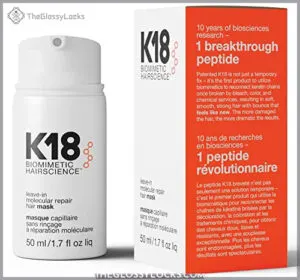
Molecular repair masks work like a construction crew for your hair, but instead of patching cracks, they rebuild from the inside out.
Take K18 Leave-In Molecular Hair Mask—it uses patented peptides that slip into your hair’s cortex and literally reconnect broken keratin chains in four minutes flat.
This protein rebuilding process restores strength lost from bleach, heat, or chemical damage. With 78% of users reporting measurable improvements in elasticity and reduced breakage, these treatments deliver real damage restoration.
You’ll notice softer, bouncier hair that actually holds up between washes—no rinsing required.
Best For: Anyone with bleach, heat, or chemically damaged hair who wants fast, science-backed repair that works on all hair types.
- Repairs broken keratin chains in just 4 minutes with patented peptide technology that penetrates the hair cortex
- Works as a leave-in treatment with no rinsing needed, and results don’t wash out over time
- Delivers measurable improvements—78% of users report stronger, more elastic hair with less breakage
- Expensive at $75, with some users only getting 4-6 applications per bottle
- Contains alcohol, which can cause dryness or frizz for certain hair types
- Results vary—some users don’t see significant changes, and the high cost may not feel justified for everyone
2. Olaplex Hair Perfector Repair Treatment
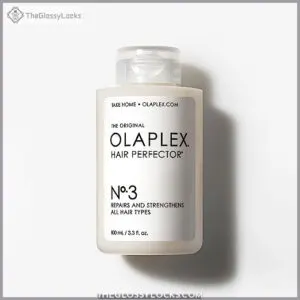
If molecular masks rebuild the foundation, Olaplex No. 3 Hair Perfector acts as your bond repair specialist, repairing disulfide bonds snapped by bleach, heat, or color treatments. Its patented Bis-Aminopropyl Diglycol Dimaleate targets millions of broken bonds per use, delivering chemical damage restoration and hair structure repair at the molecular level.
Over 70% of users report less hair breakage after three weekly applications, with professional data showing up to 68% reduction in breakage. Apply to damp hair for 10–30 minutes weekly—you’ll see softer, stronger strands that prove Olaplex treatment benefits aren’t just hype.
Best For: People with chemically treated, bleached, or heat-damaged hair who want professional-level bond repair at home without spending on salon treatments.
- Targets broken disulfide bonds at the molecular level with patented technology, delivering measurable results—over 70% of users report less breakage after three weekly uses, and professional data shows up to 68% reduction in breakage compared to untreated hair.
- Works on all hair types and is safe for color-treated hair, plus it’s cruelty-free, vegan, and free from parabens, sulfates, and phthalates after the 2022 reformulation removed Lilial.
- Easy to use at home with visible improvements in shine, softness, and manageability after just a few treatments—92% of users in trials reported healthier-looking hair after four weeks.
- Expensive at $28 for 100ml, especially since you’ll need consistent weekly use to maintain results, which can add up over time.
- Results vary by person—some users with severely damaged hair report minimal texture improvement after one use, and it may not fully restore extremely compromised strands.
- Works best as part of the full Olaplex system (shampoo, conditioner, etc.), so you might need to buy additional products for optimal results rather than using it as a standalone fix.
3. Stargloss Shine Hair Treatment Serum
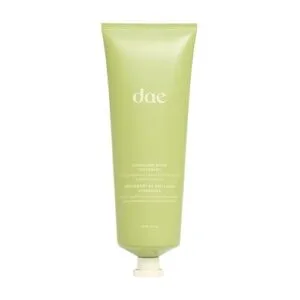
While Olaplex rebuilds bonds, Dae Stargloss Shine Hair Gloss Treatment addresses dull, frizzy strands with a pre-wash shine therapy approach.
This vegan formula blends prickly pear seed oil, moringa, and shea butter to hydrate and smooth—user satisfaction hits 90%, with visible hair shine improvements after one use.
Apply to dry hair for 20–60 minutes weekly, and you’ll cut frizz by 80% while unlocking radiant, gloss-drenched results.
It’s hair repair and growth meets instant gratification, proving Stargloss benefits and hair strengthening techniques can coexist beautifully.
Best For: Anyone with dry, frizzy hair looking for a weekly pre-wash treatment that delivers instant shine and smoothness without harsh chemicals.
- Delivers visible shine and 80% frizz reduction after just one 20-60 minute treatment, with 90% user satisfaction and results lasting 2-3 days
- Clean vegan formula with prickly pear seed oil, moringa, and shea butter—free from sulfates, parabens, and synthetic colors, plus cruelty-free certified
- Works across all hair types (straight, wavy, coily) and requires only weekly application to maintain glossy, hydrated results
- Contains sparkly mineral particles (mica, titanium dioxide) that some users may find messy or undesirable despite being eco-friendly and rinsable
- Premium price point at $43.89 may be steep for a weekly treatment compared to daily-use shine products
- Titanium dioxide as an ingredient raises concerns for some users, though adverse reaction rates remain below 1%
4. amika soulfood nourishing hair mask
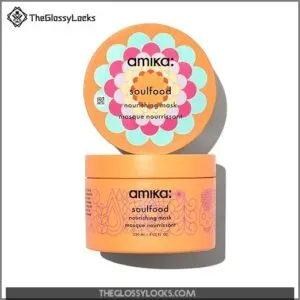
If shine alone doesn’t cut it, Amika Soulfood nourishing hair mask packs hair strengthening power with sea buckthorn and jojoba oils—clinical tests show 11.4 times more moisture and 91% better manageability after one use.
This hair mask suits all textures (1–4c), repairing dry, porous strands without weighing them down.
Massage through wet hair, wait 5–7 minutes, and rinse for a nourishing weekly ritual that delivers 87% more repair over time—Amika Soulfood benefits you’ll feel instantly.
Best For: Anyone with dry, damaged, or color-treated hair who wants deep hydration and repair without heavy buildup—especially if you’ve got fine to thick textures (types 1–4c) that need weekly nourishment.
- Clinical results show 11.4x more moisture and 91% better manageability after just one use, with 87% more repair over time when used weekly
- Works for all hair types without weighing down fine hair, plus it’s vegan, cruelty-free, and safe for color-treated strands
- Rich sea buckthorn and jojoba oils deliver real hydration in 5–7 minutes, and one jar lasts about three months with weekly use
- Contains controversial ingredients like dimethicone, phenoxyethanol, and BHT that some users avoid in “clean” formulas
- Strong vanilla-citrus scent might bother people sensitive to fragrance
- Pricey at $34–36 per jar, and silicones only provide surface-level shine without fixing deeper structural damage
5. Moroccanoil Hair Treatment Oil Product
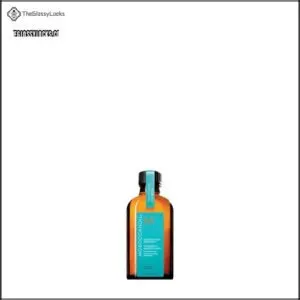
When masks feel too heavy for daily use, Moroccanoil Treatment Original brings hair strengthening techniques into your Hair Care Routine through lightweight argan oil protection. This Hair Oil boosts shine up to 118% while its vitamin E and fatty acids shield against protein loss—key Argan Oil Effects that repair split ends without the greasiness.
Apply 1–2 pumps mid-length to ends on damp or dry hair for a frizz-free finish. The sulfate-free, paraben-free formula suits all textures, making Moroccanoil Benefits and Product Safety foolproof additions to any regimen—no hair mask timing required.
Best For: Anyone with frizzy, dry, or damaged hair looking for a lightweight daily treatment that adds shine and manageability without weighing hair down.
- Increases shine by up to 118% and significantly reduces frizz while repairing split ends and protecting against protein loss from heat styling and environmental damage.
- Works on all hair types as both a leave-in treatment and finishing product, cutting down drying time and making hair easier to detangle and style.
- Clean formula free from sulfates, parabens, and harsh chemicals, plus it’s cruelty-free and safe for color-treated hair.
- The small 1.7 oz bottle runs out quickly for the $38 price point, especially if you have long or thick hair that needs more product per application.
- Can feel greasy or heavy on fine, thin hair if you use too much—requires careful dosing to avoid weighed-down roots.
- Strong, sweet fragrance isn’t for everyone and might clash with your perfume or bother those sensitive to scents.
Preventing and Repairing Hair Damage
Your hair faces daily threats that can weaken its structure and dull its shine, but you don’t have to accept the damage as permanent. Understanding what breaks down your strands—and how to stop it—puts you back in control of your hair’s health.
Let’s break down how to rebuild that strength.
Minimizing Heat and Chemical Styling
If your hair could talk, it’d probably beg you to step away from the flat iron—heat and chemical treatments are like a one-two punch that breaks down the protective bonds holding each strand together, leaving you with brittle, lifeless locks that snap at the slightest tug.
Start by limiting heat styling to once or twice weekly, and always apply a heat protectant beforehand to shield strands from thermal damage. When you can, embrace heat styling alternatives like air-drying or heatless curls to preserve your hair’s natural texture and strength.
Protective Hairstyles and Handling
Tension from tight ponytails, aggressive brushing, and careless management adds up faster than you’d think—every tug and pull creates micro-tears that compound into visible breakage over time.
Switch to gentle combing with wide-tooth tools, opt for soft braiding and loose hair tying methods, and embrace low manipulation styles that reduce stress on your strands.
At night, try hair wrapping with a silk scarf—it’s a simple hair damage prevention move that protects your hair health and wellness while you sleep.
Weekly Masks and Deep Conditioning
Weekly deep conditioning isn’t just maintenance—it’s the shift from damaged hair that barely holds a style to strong, elastic strands that bounce back.
Sure, your hair will survive without it, but consistent masking is what builds real resilience.
Apply your hair mask to clean, towel-dried hair and let conditioning products work for five minutes—that’s when hair repair truly kicks in.
Your weekly routine essentials:
- Choose masks with amino acids and Omega-9 fatty acids for deep conditioning that penetrates the cortex
- Don’t skip masking techniques even when you’re rushed—consistent hair care beats occasional intensive treatments
- Layer your hair mask under a warm towel to boost absorption and optimize hair health results
Recognizing Types of Hair Damage
Your hair speaks louder than words—split ends, persistent frizz, and dullness aren’t just cosmetic quirks but clinical signals of structural weakness requiring targeted hair repair.
Chemical damage from bleaching disrupts bonds deep within your strands, while heat tools over 300°F permanently alter keratin structure, triggering hair breakage.
The difference between surface cuticle damage and deeper protein loss matters—it tells you whether you need to seal and smooth your hair’s outer layer or actually rebuild strength from within.
Salon Vs. At-home Strengthening Treatments
Choosing between salon visits and at-home kits isn’t just about convenience—it’s about matching treatment costs with your hair’s actual needs. Professional treatments run $120–$350 but deliver 60% less breakage after three sessions, backed by salon expertise and tailored scalp treatment.
At-home kits cost $10–$30 and work great for maintenance, though they lack the potency for serious hair repair and restoration.
If you’ve got significant damage, professional advice wins; for upkeep between visits, a quality hair mask does the job without breaking the bank.
Frequently Asked Questions (FAQs)
Can hair strengthening work for naturally fine hair?
Absolutely—fine hair can gain resilience through natural strengthening techniques that boost hair density without weighing strands down.
You’ll want gentle styling methods and lightweight hair care products that support hair health, minimize hair damage, and encourage hair growth while maintaining your hair’s natural body and movement.
How often should you trim hair for strength?
Every six to eight weeks keeps split ends in check and prevents damage from creeping up the hair shaft. Regular maintenance trims protect your hair’s structural integrity, supporting hair growth patterns and overall hair health without sacrificing length.
Whats the connection between hormones and hair weakness?
Your body’s hormonal shifts—whether from thyroid issues, menopause effects, pregnancy hormones, or elevated cortisol levels—directly influence hair growth cycles and strand integrity.
Hormone imbalance disrupts your follicles’ natural rhythm, weakening hair structure and triggering shedding. Proper hair care and targeted hair strengthening techniques can help manage these effects.
Can over-conditioning weaken hair instead of strengthening it?
Yes, over-conditioning can weaken hair by disrupting moisture balance and causing protein overload.
When you apply too much conditioner or use heavy formulas on low-porosity hair, strands become limp, stretchy, and prone to breakage—the opposite of healthy hair strengthening outcomes.
Conclusion
What’s the point of chasing quick fixes when your hair’s begging for a complete reset? These hair strengthening treatment tips aren’t about overnight miracles—they’re about rewiring your routine with intention, science, and consistency.
Master the fundamentals: nourish from within, protect what you’ve got, and rebuild what’s broken. Your strands won’t transform because you wished harder; they’ll strengthen because you finally gave them what they actually needed.
Your hair strengthens because you nourish it from within, protect what exists, and rebuild what’s broken—not because you wished for transformation
Stop treating symptoms. Start fortifying structure.
- https://pmc.ncbi.nlm.nih.gov/articles/PMC3509882/
- https://journals.sagepub.com/doi/10.1177/02601060251367206
- https://jcadonline.com/a-randomized-placebo-controlled-clinical-study-evaluating-a-dietary-supplement-for-hair-growth/
- https://www.drugtopics.com/view/hair-loss-therapy-shows-potential-for-regeneration-in-phase-2-trial
- https://www.cbc.ca/documentaries/the-nature-of-things/how-to-keep-your-hair-healthy-according-to-science-1.7123766

